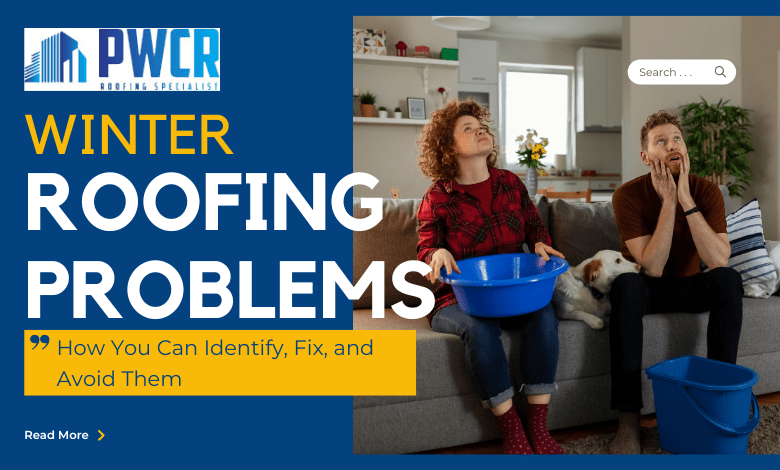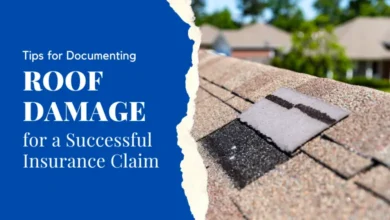Winter Roofing Problems: Identify, Fix, & How to Avoid

Roofs face tough weather in winter, but it’s a great time to enjoy the outdoors. Whether you live in an area with snow or just experience freezing temperatures, winter can wreak havoc on your roof. And unless you’re attentive to potential problems, it could lead to bigger issues down the road. Here are some common issues that homeowners may encounter over the winter:
6 Potential Roofing Issues Homeowners May Face over the Winter
1. Condensation
Condensation is a common problem that can lead to significant damage. It occurs when warm air from inside your home comes into contact with cold surfaces on the roof or attic, such as insulation and ductwork. The resulting moisture will condense on these surfaces and begin to drip down onto your walls and floors inside the house.
Excessive heat loss through poorly insulated attics causes the main cause of attic moisture in winter. Poor insulation causes temperatures inside to drop below freezing even though it’s still 60 degrees Fahrenheit (15 degrees Celsius) outside. Ice dams form along eaves and cause leaks into basements, bedrooms, and damage furniture/carpets through cracks in floorsboards.
2. Ice Dams
The Ice dams are a common problem in the winter, and they can cause damage to your roof. Ice dams form when heat from your home melts snow on the roof, which then refreezes and backs up under shingles. This can lead to leaks and water damage inside your home if not addressed quickly enough.
Avoid ice dams by insulating your house, reducing heat loss and moisture buildup in winter. Consider a new roof for an older, poorly insulated home before next winter.
3. Leaky Flashings
Leaky Flashings are the metal pieces that seal the joints between your roof and walls or other structures. They often get damaged, allowing water to seep into your home and cause damage. If you notice any of these signs, it’s likely that there are leaky flashings on your roof:
- There are puddles around vents or chimneys (this may also be caused by poor ventilation).
- You have mold growing in the attic–or even inside the house!

4. Tree Limbs
Tree limbs are a common culprit of roof damage. They can cause broken shingles, dents and cracks in your roofing materials, or even worse–a hole in your roof! As you walk around your property this winter and spring, look for branches that may have fallen during high winds or heavy snowfall. If you find one that has fallen across the top of your home’s exterior walls or onto a nearby window (which could lead to expensive repairs), remove it immediately by cutting off any branches that extend beyond where they should be positioned and then disposing them properly. This will help prevent further damage from occurring later on down the line if another storm hits while this branch remains unattended-to outside where it might fall again due to high winds or heavy snowfall.
Tree limbs falling caused damage to house exterior, e.g. cracked shingles, roof tiles, siding panels. We recommend you repair them immediately before further deterioration occurs.
5. Animals
You may have heard of the term “nest” before, but what does it mean? A nest is simply a place where animals gather to sleep or raise their young. For example, squirrels will often build nests in attics or on roofs because they’re warm and dry–and these types of structures provide excellent protection from predators like hawks and owls. Raccoons make their homes in attics or on roofs during winter months to conserve energy and wait for springtime to arrive when they can hunt again.
If you’ve ever had an animal living in your house (or even if you haven’t), then you know how destructive these furry intruders can be! They aren’t just being rude: they’re also causing problems with the roofing material itself–and even worse yet…they can ruin insulation too! That’s right: if there’s one thing we know about squirrels and raccoons today…it’s that these little guys love chewing things apart with their sharp little teeth!
6. Snow and Ice Buildups
If you’re not careful, snow and ice buildups can cause serious damage to your roofing system. Unchecked problems lead to leaks that damage the home.
The signs of a buildup include:
- Water stains on the ceiling or walls of your home. These are usually caused by water leaking through holes in the shingles or around windowsills where ice has formed at night when temperatures were low enough for this type of precipitation but too warm for it to freeze completely over time (the process that creates snow).
- Damage around attic vents; if these are blocked by ice buildup, condensation will form inside instead of escaping via ventilation channels as intended by design engineers who designed them into homes with this purpose in mind! Call a professional if you notice signs like these, as fixing may require removing wall parts which can be dangerous without proper training, equipment, and tools
How Can I Avoid Wintertime Roof Problems?
- Ventilation. Make sure your properly insulated attic is vented. You may need to add more insulation if there isn’t enough.
- Inspection and maintenance. Inspect and repair roof annually for damage/leaks to avoid springtime complications.
- A reliable contractor should install new materials following manufacturer specifications for the best results.
Conclusion
We hope this article helped you identify and prevent common winter roofing problems. If you have any questions or need roofing services, PWCR is a commercial roofing company in St. Catharines that provides affordable roofing, roof repair, and installation. Please Contact Us Today! We’re here to help with everything from repairing leaks and cracks in your roof through installing new insulation for extra warmth in the colder months ahead.
Explore our blog for intriguing content by visiting our site today.




